I was more impressed with Mesa Verde than I expected to be. It has a unique place in our National Park System. Whereas other national parks are primarily oriented to provide "wilderness" and recreational opportunities, Mesa Verde National Park exists to preserve a cultural resource, the culture of a prehistoric people we know very little about. There are few, if any, wilderness options for recreationists. Instead, the park is about education, wonderment, and meditation. I was impressed by the sensitivity and knowledge of each of the rangers we listened to and by the genuine curiosity and respect of couples and families who had come to the park.
It is easy to romanticize the ruins and imagine cliff dwellers as hyper-spiritual mystics. But I think Janet was right: in 1250 the canyons on Mesa Verde must have been noisy places. These were places of constant building and repairs, of work producing pottery and grinding maize, of children playing (or falling to their deaths), of dancing and singing. From overlooks a quarter mile away, we could hear rangers converse with tourists in the alcoves of the cliff dwellings. Surely, one would have heard a constant buzz when the canyons were alive with real people, living real lives, not touring the past.
We got tickets to Long House first, because it would not remain open much longer.
The drive to Wetherill Mesa, where it is located, is a steep, winding 12-mile excursion across the park. Only about 10% of park visitors bother with it.
But Long House, only "stabilized" in the 1960s, is as large as the famed Cliff Palace.
In many ways it is more exciting than Cliff Palace. The walk down to it is gorgeous
and the "House" appears as one turns a corner.
Of course, it was not a residence, but a village
--a place of work, play, feasting, and dancing. (The use of names like "House" and "Palace" and "Temple" are unfortunate byproducts of the early Anglo discoverers, especially the Wetherills.)
My interest turned to the large dance plaza that must have been a ceremonial center for several villages in nearby canyon locations.
(Ranger Jim was particularly knowledgeable and enthusiastic about Long House.) Notice the huge firepit and floor drums.
The stone pits on either side would probably have been covered and dancers would have used their feet to create a rhythm and ritual pulse. To dance would have reminded them of their roots to the earth itself and the rhythms of life and death. Even today, native Americans dance to the sound of huge drums which trained drummers together strike with a powerful unison beat.
We hiked to Step House,
which included an earlier Pueblo I "pit house" that demonstrated how the early Puebloans constructed their residences.
These early pithouses were relatively shallow and lined with large stone slabs.
They were surprisingly effective geo-thermally, more so than later above-ground stone buildings. Of course, strategically chosen alcoves also provided considerable geo-thermal advantages in summer and winter. We could feel both the radiant heat and the cooling shade as we moved through these alcoves.
Step House is important because it has petroglyphs that relate to much of the Anasazi rock art we have been seeing in the SW.
Some scholars believe that these petroglyphs may also reference solar or stellar events.
Our favorite "cliff-dwelling" was Spruce Tree House,
which has been very popular since the park opened in the early 1900s. (Actually those are Douglas Firs around the cliff-dwelling, not spruces. But don't be pedantic where romance is involved.) The approach is guarded by oaks,
which correctly suggests that there is one of the few springs of water on Mesa Verde nearby. (It used to be the prime source of water for the first park visitors.)
Spruce Tree House is the third largest cliff-dwelling in the park and, fortunately, is a self-guided tour.
The bones of female skeletons consistently show damage to the elbows and shoulders from years of grinding. The walls of the buildings and kivas were once plastered and decorated with patterns similar to those found on Mesa Verde pottery.
The constant upkeep of the plaster and artwork was one of the many ongoing tasks of maintaining an active ancestral Puebloan village.
But, for us, the most exciting aspect of Spruce Tree House was our discovery of signatures that go back to the earliest discoverers and archaeologists. The ranger who was guarding the ruins confirmed to us that the initials "J.W." did in fact belong to John Wetherill.
He was the brother of Richard Wetherill, who discovered Cliff Palace along with Charlie Mason, his brother-in-law, while they were out looking for their wandering cattle. I have seen photographs taken in the early 1890s of John sitting in Spruce Tree House when it was still "unstable." The other piece of graffiti belonged to Gustaf Nordenskiold, the young Swedish archaeologist who was the first professional to work with the Wetherills in establishing the importance of Mesa Verde.
He marked each site with a number. My research suggests that there are other inscriptions hidden in Spruce Tree House, but we decided not to take advantage of our ranger's patience any further.
The whole time we were there, the turkey vultures seemed to be having a great time soaring and swooping.
Perhaps they were simply bemused in the strange behavior of the humans who tramped through their canyon.
Or, more ominously, perhaps they had their eye on refreshments.


























No comments:
Post a Comment